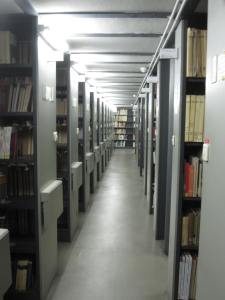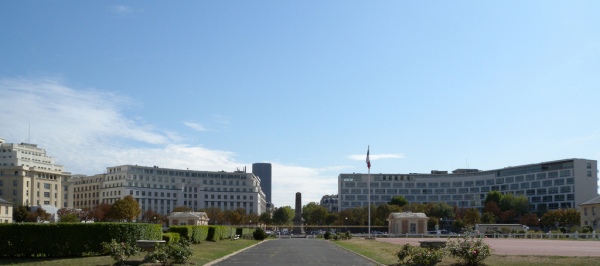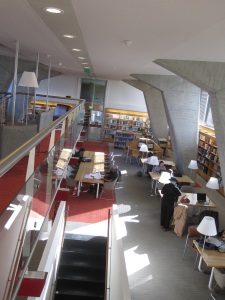Of all the libraries I visited during my travels, UNESCO ranks up there as one of my favourites. See, I heard a lot about UN agencies during my undergraduate degree in International Development, which made my visit to UNESCO something of a pilgrimage. I suppose it might be a bit like an English major visiting the birthplace of Jane Austen or a biology grad stopping by Sir Alexander Flemming’s lab.
Before I start discussing my library visit, I want to explain a little about the organization itself. Many of you will have heard of UNESCO in the context of its World Heritage Site program, which includes marvels such as L’Anse aux Meadows, the Statue of Liberty, and the Taj Mahal. However, UNESCO does so much more than this. As the United Nation’s Educational, Scientific and Cultural organization, UNESCO is supposed to contribute to:
the building of peace, the eradication of poverty, sustainable development and intercultural dialogue through education, the sciences, culture, communication and information.
All in a day’s work, right? This exceptionally broad mandate includes quite a few projects which fall into the LIS domain. Parallel to the better-known World Heritage Sites, the Memory of the World Register aims to aid in the preservation and dissemination of the world’s documentary heritage. Another project, titled “Information for All,” exists to “create equitable societies through better access to information.”
In the past UNESCO has been even more active in supporting global librarianship and was instrumental in the development of IFLA. If you are intrigued by this history, Professor Peter Lor, former DG of IFLA, has written a thorough history of UNESCO and libraries.
Library
UESCO world headquarters are located in the swanky 7th Arrondissement in Paris, which is also home to the Eiffel Tower, the Musée d’Orsay, and more beautiful Haussmannian buildings than you can shake a stick at. The library is found a few steps inside the main entrance in a purpose built space lined with bookshelves and lit principally by the sunlight streaming in the large windows. Incredibly in this post 9/11 world, anyone with a valid passport can enter the UNESCO headquarters to use the library (although that may soon change). On the day of my visit the reading room was populated by students, visiting researchers, and retirees, in addition to UNESCO staff.
The atmosphere in the reading room was that of any research centered library, though the posters and artwork remind visitors that the focus is the developing world. Behind the scenes, however, one of the major differences between being a UN library compared with another type is the uncertainty around funding. While budget stability is a perennial challenge for most libraries, it is particularly felt by UN special agencies because their funding is dependent on international relations. Currently UNESCO is facing a 22% budget cut because the US withdrew their funding after Palestine was made a voting member. As the organization struggles to preserve programs, the cuts passed on to the library will certainly be greater than 22%. In the library, that means no collections budget, a merger between the library and archives into a new department called “Information Services” and staff redundancies are a distinct possibility. Due to the legendarily slow speed of UNESCO decision waiting, the library will be kept in limbo a while longer before the budget shortfall effects trickle down through the organizational hierarchy.
The facility

Only the most popular works are stored in the shelves in the reading room. The remaining 95% of the collection are found in the second basement.
As I mentioned, the library space was purpose-built to serve as an information centre. The location of the reading room on the ground level is deceptive; a staircase in the centre of the room leads to the archives one floor below and from there to the storage facilities in the second basement. The storage facility holds the archives in huge compact shelving and the vast majority of the library collection on plain grey shelves. A challenge for staff is that their collection of nearly 150,000 works is so large and specialized that the DDC call numbers are very difficult to use.
Day-to-day tasks at the library include online reference support, answering questions by email, and assisting walk-in users of the library and archives. In the past the library staff were also called upon to support UNESCO programs involving libraries in other parts of the world. However, this role has been eroded to the point where present day staff are limited to traditional functions within the UN library system.
The future
The UNESCO library faces some substantial challenges moving forwards. First, of course, are the massive budget cuts which are now falling on the entire headquarters.
Second, the library is suffering from declining usage. Librarian Petra van den Born reports that new UNESCO staff are often unaware of the library services or believe that their Googling abilities are sufficient for their research needs. With funding reductions, it is difficult for library staff to plan training sessions, establish outreach or introduce social media based techniques to increase their visibility.
Finally, senior management at UNESCO has begun to question the value of the information services, particularly the physical print collection. As the library’s role has shrunk within the organization and as managers are younger and less likely to have used a library in the past, it will be a challenge for the Information Services staff to demonstrate their relevance and value.
Visit the UNESCO library homepage here
My sincere thanks to reference librarian Petra van den Born for showing me the library and sharing her experiences.
Top photo credit: Jirome Bon http://www.flickr.com/photos/girolame/


